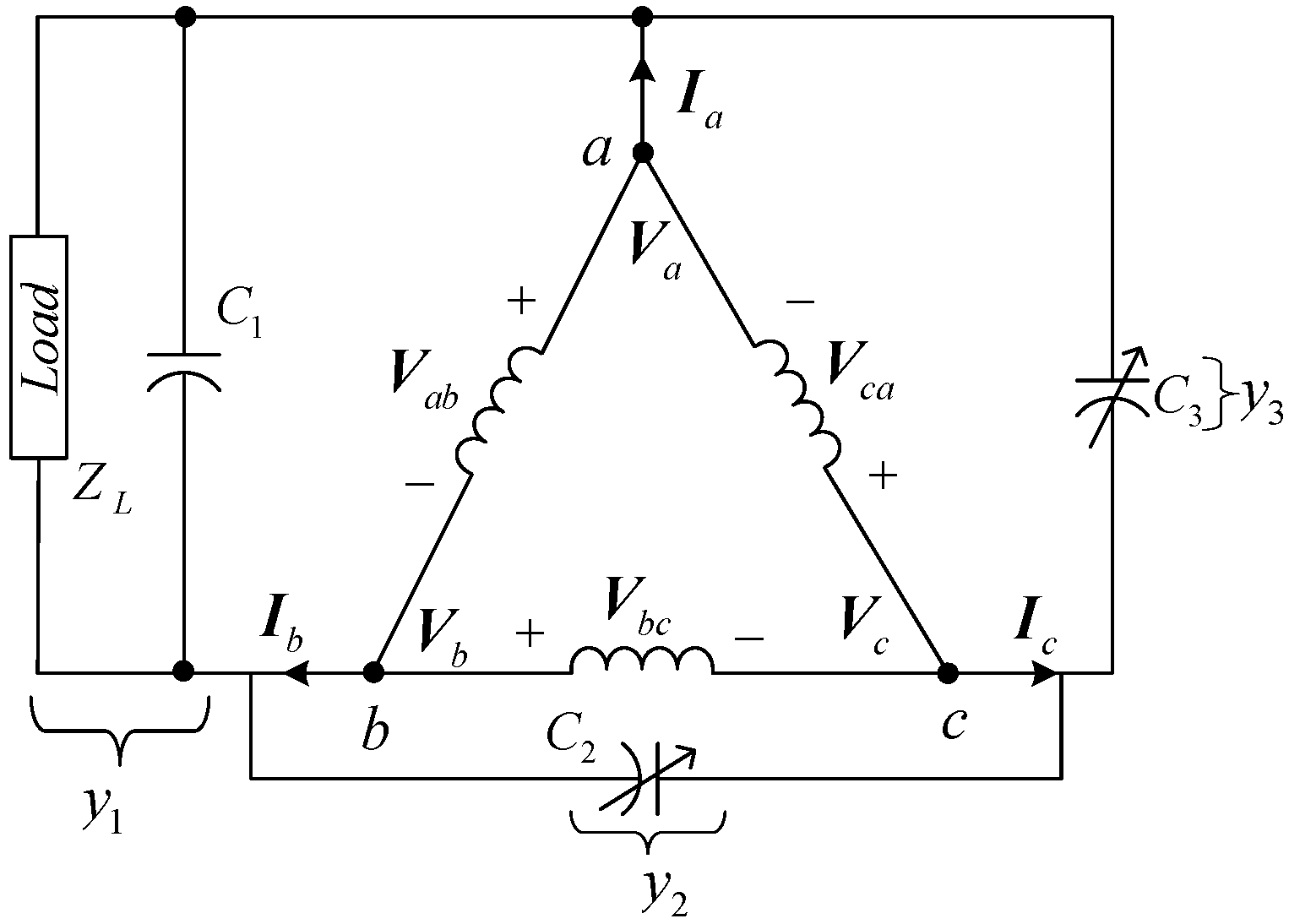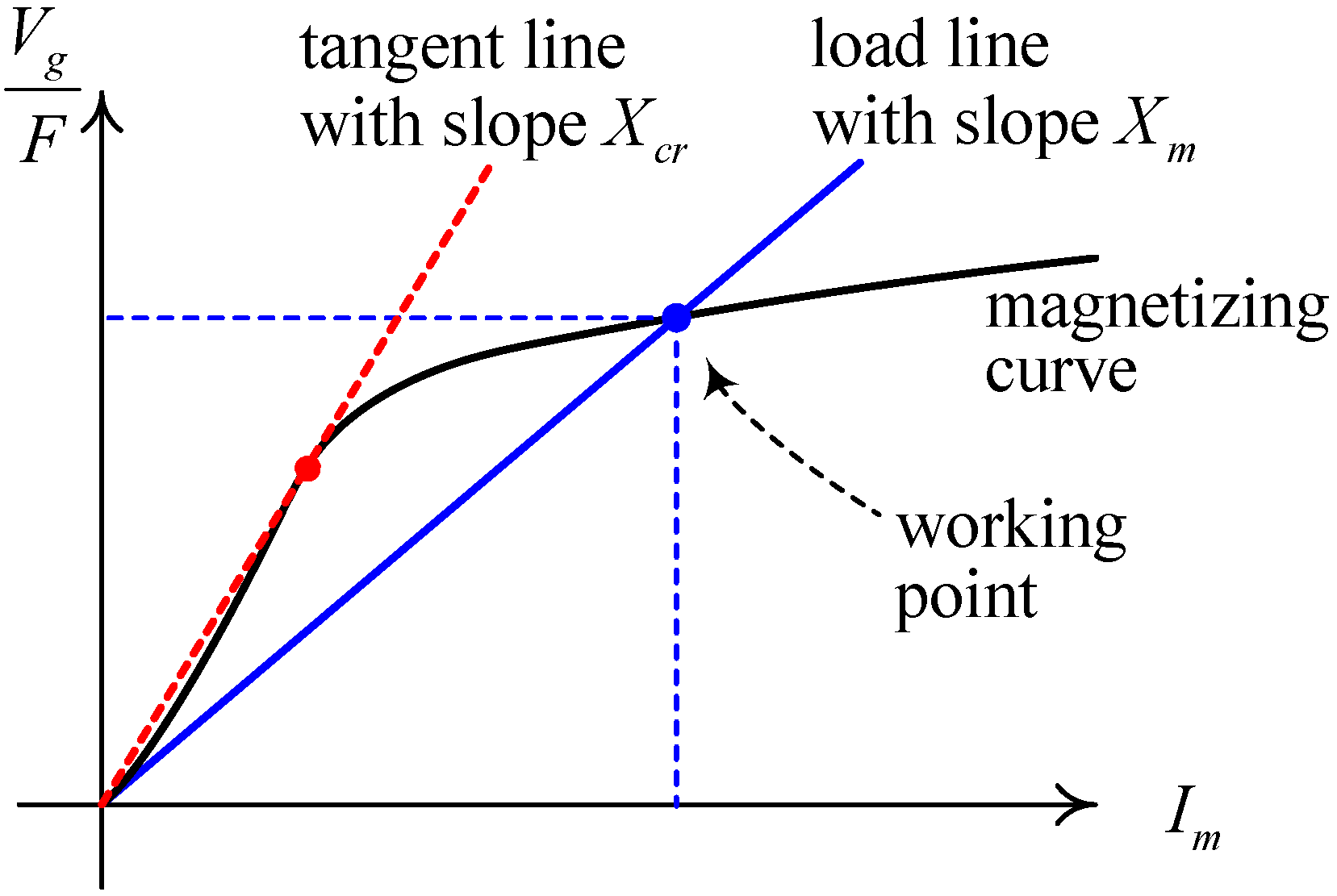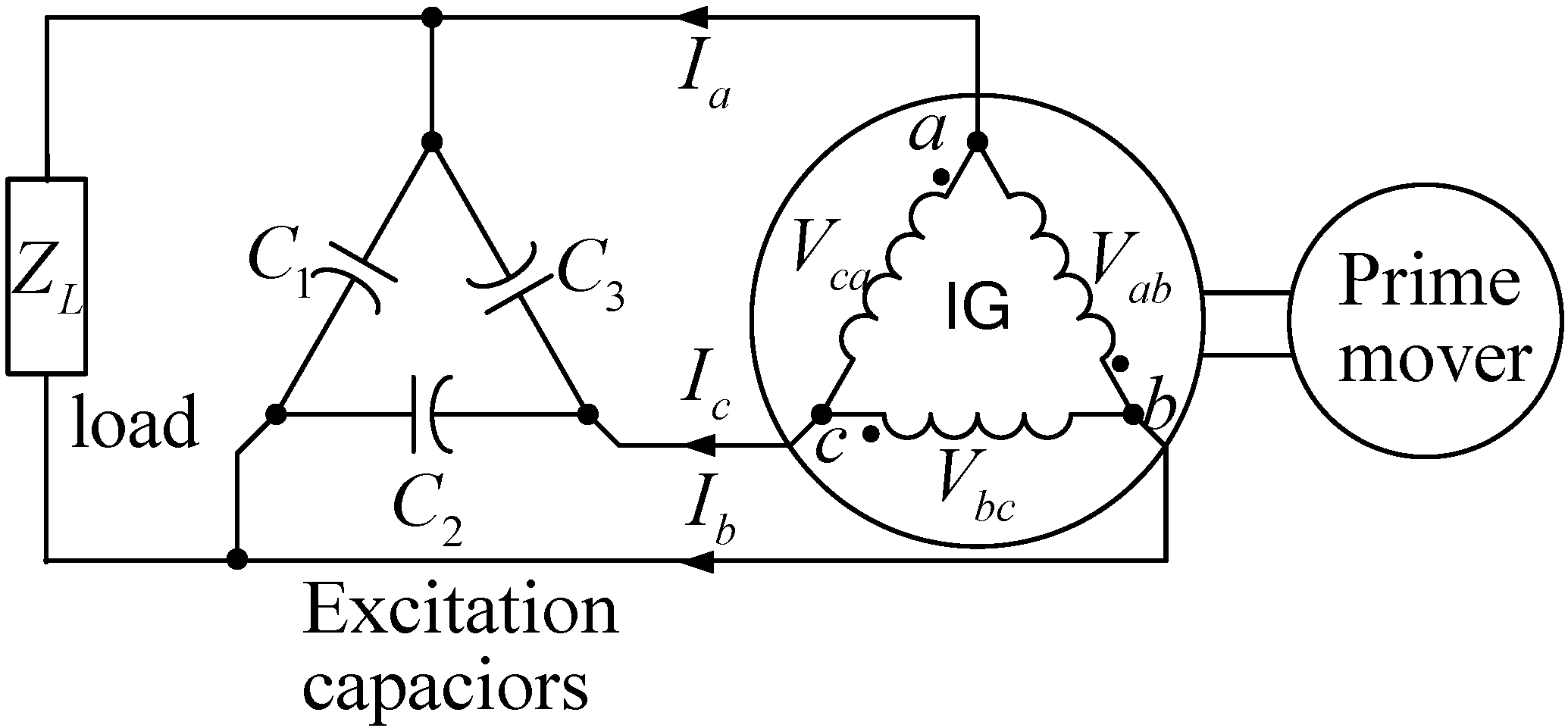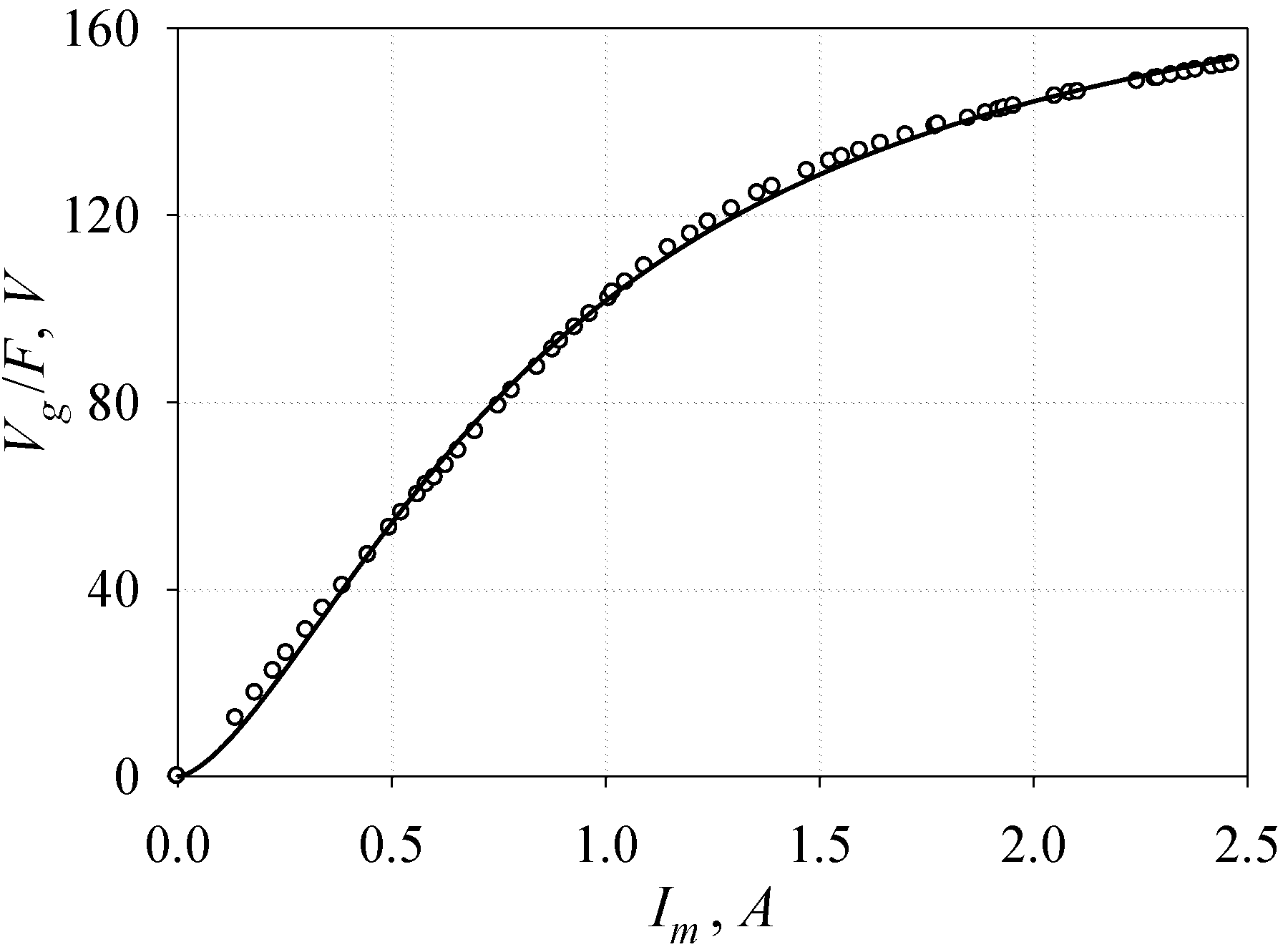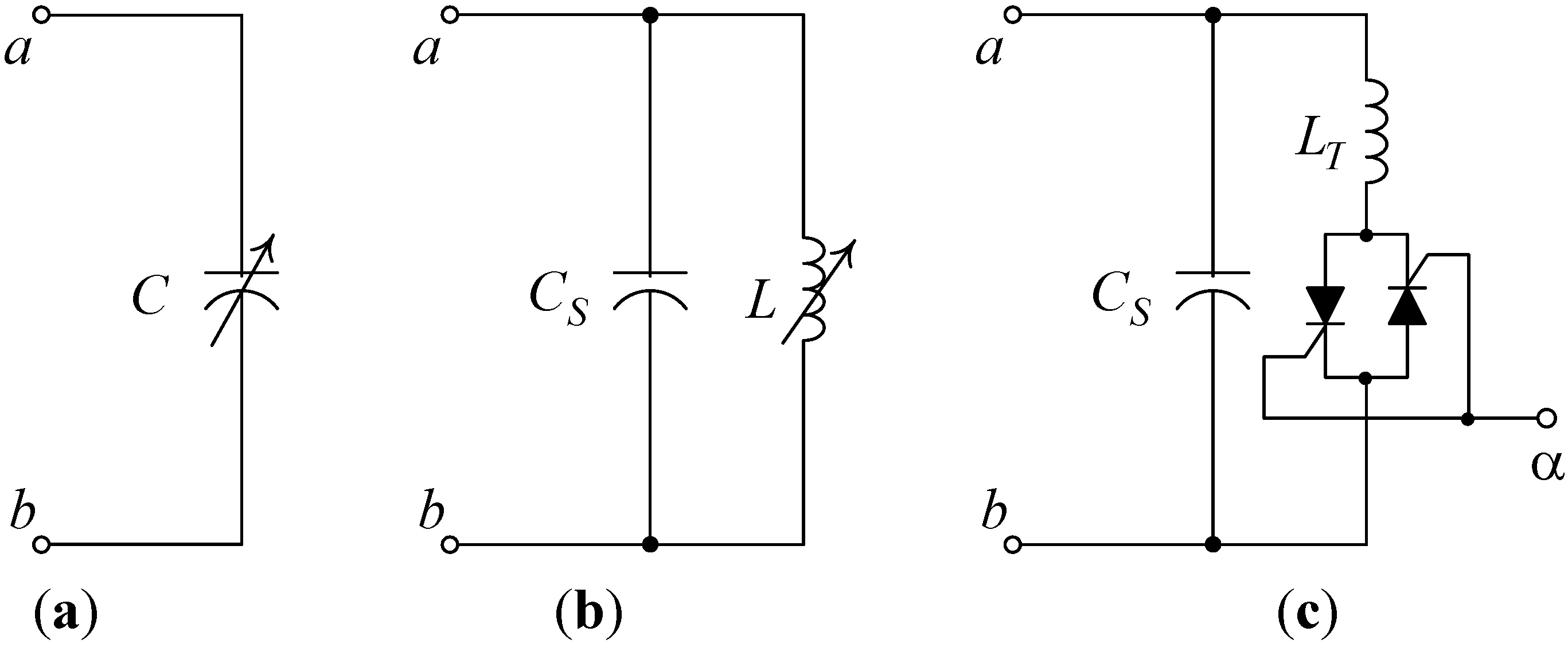1. Introduction
Induction generators (IGs) are receiving more attention than in the past because of their low prices, simple construction, little maintenance, ruggedness and the fact they do not need dc sources and brushes, which make them particularly suitable as an energy conversion device for renewable energy sources such as wind, biogas and micro-hydro. In many developing countries where a significant percentage of the population and areas still suffer from electricity shortages, employing IGs for generating electricity from renewable energy has become an important means of rural electrification and reduction of greenhouse gases emissions [
1].
IGs can be operated in stand-alone or grid-interactive mode. In grid-interactive mode, an IG is directly connected to the grid that imposes its voltage and frequency and supplies the required reactive power. The analysis of a grid-connected IG does not differ much from that of an induction motor (IM). On the other hand, in stand-alone mode, self-excitation capacitors are needed to supply reactive power to the generator and load, and the generated voltage and frequency depend on the rotational speed, the load impedance and the values of excitation capacitors. Hence, the analysis of a self-excited induction generator (SEIG) is more complicated.
People living off the grid in remote islands, rural or mountain areas usually have single-phase type loads. Hence, a single-phase SEIG is an ideal option for electric power supply. While high capacity single-phase IMs up to 10 hp are available in the market, three-phase IMs above 5 hp (3.7 kW) are cheaper than single-phase IMs of the same ratings [
2]. The use of a three-phase IM operated as an SEIG to generate single-phase electricity has been employed in many places for economic reasons. However, a three-phase SEIG operated as a single-phase generator is working under a very unbalanced condition, necessitating it to be derated to avoid overheating.
In the literature, studies on the three-phase SEIG feeding single-phase loads can roughly be categorized into two groups. The first group endeavors to minimize the voltage regulation and at the same time maximize the single-phase power output of the generator by properly choosing the values of the self-excitation capacitors, considering possible changes in the rotational speed of the prime mover. To mention some examples, Wang and Cheng [
3] determined the minimum and maximum values of a single excitation capacitor required by a three-phase SEIG supplying a single-phase resistive load using the eigenvalue sensitivity method. Fukami
et al. [
4] proposed and analyzed a self-regulated three-phase SEIG working as a single-phase generator that consisted of two equal capacitors connected in series and another capacitor in parallel with the load resistor, and provided improved performance of voltage regulation. This generator scheme was further optimized by Mahato
et al. [
5] using the sequential unconstrained minimization technique to obtain a maximum power output for both capacitive and inductive single-phase loads.
The second group stresses the need for mitigating the voltage and current unbalance of a three-phase SEIG working as a single-phase generator. Al-Bahrani and Malik [
6] analyzed the performance of a three-phase SEIG composed of a single capacitor in parallel with a single-phase load,
i.e., the single-phasing mode. Chan [
7] developed a method based on symmetrical components for analyzing a three-phase SEIG supplying a single-phase load. Chan’s method was applicable to the single-phasing mode as well as the Steinmetz connection. Chan and Lai [
8,
9] also developed a method to determine the minimum capacitance for voltage building-up of a three-phase SEIG with Steinmetz connection. It is noted that [
6,
7,
8,
9] only give methods for analyzing a three-phase SEIG feeding a single-phase load and do not report any method for balancing it. Chan and Lai [
10] proposed a circuit scheme to balance the SEIG. In addition to the load resistance and excitation capacitance in the Steinmetz connection, they added an auxiliary load resistance and an auxiliary excitation capacitance. They used a phasor diagram to explain how to find the appropriate values of the auxiliary resistance and capacitance that allow a perfectly balanced three-phase voltage and current to be obtained. Alolah and Alkanhal [
11] proposed another scheme that consisted of two excitation capacitors, the values of which were determined using a sequential genetic and gradient optimization method. The voltage unbalance factor of the SEIG using the capacitance values found by that proposed algorithm was reported to range from 2% to 7%, showing a system that is not perfectly balanced.
In fact, achieving balanced loading on a three-phase generator provides benefits to the generator’s performance which include: (1) making full use of the generator rating; (2) eliminating the pulsating torque caused by the negative-sequence current and hence reducing shaft mechanical vibration; and (3) eliminating voltage unbalance at the generator terminals caused by unbalanced load currents, which also improves voltage regulation of the generator.
In this paper, the authors propose a three-capacitor scheme that is able to perfectly balance a three-phase SEIG supplying a single-phase load. The three capacitors include a fixed capacitor that supplies the required reactive power to the system, and two variable capacitors that play the role of balancer. The two variable capacitors can be realized by two static var compensators (SVCs), a parallel combination of a fixed capacitor and a thyristor-controlled reactor (TCR). The three-capacitor scheme is represented by a two-port network IG model developed by Wang and Huang [
12] for analysis. A solution method based on this two-port network model is also proposed for determining the values of the three capacitors. The circuit scheme and the method for finding capacitances to balance the SEIG are validated by comparing results obtained by the two-port network SEIG model and by experiments on a 0.375 kW induction generator.
3. The Solution Method
The analysis in
Section 2 reveals that the voltage unbalance factor τ of the SEIG is determined by the ratio of
yβ to
Ynth. When the SEIG is working at a balanced condition, the voltage unbalance factor τ must be equal to zero, which means that the numerator of Equation (20) is zero. Namely, the real and imaginary parts of admittance
yβ must both be zero. These two conditions combined with the relation for the per unit frequency
F described by Equation (16) allow the following three simultaneous nonlinear equations to be written:
Given that
C1 and
ZL are known, the values of
F,
C2 and
C3 can be found by solving Equations (16,21,22) using the Newton-Raphson method if appropriate initial guess values are provided. The obtained values of
C2 and
C3 allow the SEIG to work at a balanced condition. In comparison with the Hooke and Jeeves search technique used in Chan’s work [
7], the proposed method of directly solving three simultaneous nonlinear equations is much easier. In this paper, the nonlinear simultaneous equations have been solved using Mathcad [
13], which is a widely used general-purpose mathematic software tool.
4. Numerical Applications
An induction motor working as an SEIG supplying a single-phase load has been used to illustrate the proposed methods for solving
C2 and
C3 to balance the generator. It has been set up as shown in
Figure 5. The generator is a 3-phase, 220-V, ∆-connected, 60-Hz, 4-pole, 1/2 hp squirrel-cage induction machine. The motor characteristics and test methods for obtaining the parameters of the generator equivalent circuit are given in the appendix. Also included in the appendix are the test method for the magnetizing saturation curve, and how the fixed capacitor
C1 is determined in this study.
Figure 5.
Experimental set-up of an SEIG feeding a single-phase load.
Figure 5.
Experimental set-up of an SEIG feeding a single-phase load.
In the following sections, we firstly show a few examples of applying the proposed solution method for finding the values of C2 and C3 that balance the generator when ZL, C1 and the rotational speed are known. The example that follows is the use of the capacitance values found by the solution method for the experiment on the 1/2 hp squirrel-cage induction machine to see whether the generator is working under balanced conditions.
4.1. Verification of the Obtained Capacitance Values
The solution method described in
Section 3 has been employed to find the values of
C2 and
C3 when the generator runs at 1764 rpm and
C1 is fixed to 10 μF. The solved results for resistive loads
ZL = 400 Ω and
ZL = 1000 Ω, and inductive loads
ZL = 500 +
j1130.97 Ω and
ZL = 467.13 +
j123.91 Ω (at 60 Hz) are shown in
Table 1.
In the table, the values of τ corresponding to the solution values of
C2 and
C3 are also listed, being all very close to zero and showing that the obtained capacitance values can balance the generator. The values of the magnetizing reactance
Xm listed in
Table 1 are all smaller than
Xcr/
F, meaning that the capacitance values obtained allow the generator to build voltage.
Table 1.
Capacitance values C2 and C3 and the resulting voltage unbalance factor for different load impedances at a rotating speed of n = 1764 rpm.
Table 1.
Capacitance values C2 and C3 and the resulting voltage unbalance factor for different load impedances at a rotating speed of n = 1764 rpm.
| n (rpm) | 1764 |
|---|
| ZL (Ω) | 400 Ω | 1000 Ω | R-L (series)
R = 500 Ω, L = 3000 mH | R//L (parallel)
R = 500 Ω, L = 5000 mH |
| C2 (μF) | 13.98 | 11.58 | 8.490 | 11.66 |
| C3 (μF) | 6.019 | 8.421 | 7.420 | 5.321 |
| τ (%) | 1.86 × 10−6 | 2.97 × 10−7 | 1.62 × 10−7 | 3.7 × 10−7 |
| Pout (W) | 125.76 | 57.27 | 9.17 | 59.20 |
| F (p.u.) | 0.96182 | 0.97004 | 0.97543 | 0.96590 |
| Im (A) | 1.36 | 1.49 | 0.83 | 0.90 |
| Xm (Ω) | 93.44 | 89.10 | 110.98 | 108.98 |
The values of
C2 and
C3 solved by the proposed method for operating conditions of
n = 1800 rpm with load
ZL equal to 500, 2000, 600 +
j1357.16 and 373.7 +
j99.12 Ω (at 60 Hz), respectively, are listed in
Table 2, in which the resulting voltage unbalance factors τ are small too, verifying that the obtained capacitance values can balance the generator. Checks on the magnetizing reactance
Xm also assure building-up of the generator voltage.
Table 2.
Values of C2 and C3 for different load impedances at a speed of n = 1800 rpm.
Table 2.
Values of C2 and C3 for different load impedances at a speed of n = 1800 rpm.
| n (rpm) | 1800 |
|---|
| ZL (Ω) | 500 Ω | 2000 Ω | R-L (series)
R = 600 Ω, L = 3600 mH | R//L (parallel)
R = 400 Ω, L = 4000 mH |
| C2 (μF) | 13.11 | 10.77 | 8.769 | 12.07 |
| C3 (μF) | 6.887 | 9.229 | 7.930 | 4.285 |
| τ (%) | 3.18 × 10−7 | 1.94 × 10−7 | 0.0041 | 0.00019 |
| Pout (W) | 118.98 | 33.22 | 12.35 | 69.35 |
| F (p.u.) | 0.98395 | 0.99249 | 0.99528 | 0.98297 |
| Im (A) | 1.53 | 1.66 | 1.14 | 0.85 |
| Xm (Ω) | 88.09 | 84.13 | 100.93 | 110.46 |
The values of
C2 and
C3 found for operating conditions of
n = 1836 rpm with load
ZL equal to 600, 3000, 700 +
j1507.96 and 560.55 +
j148.69 Ω (at 60 Hz), respectively, are summarized in
Table 3. The resulting voltage unbalance factors are again very close to zero. Voltage building-up is also checked for each loading condition.
Table 3.
Values of C2 and C3 for different load impedances at a speed of n = 1836 rpm.
Table 3.
Values of C2 and C3 for different load impedances at a speed of n = 1836 rpm.
| n (rpm) | 1836 |
|---|
| ZL (Ω) | 600 Ω | 3000 Ω | R-L (series)
R = 700 Ω, L = 4000 mH | R//L (parallel)
R = 600 Ω, L = 6000 mH |
| C2 (μF) | 12.54 | 10.50 | 8.961 | 11.38 |
| C3 (μF) | 7.461 | 9.496 | 8.215 | 6.306 |
| τ (%) | 1.12 × 10−6 | 5.88 × 10−9 | 2.25 × 10−7 | 3.97 × 10−8 |
| Pout (W) | 113.21 | 24.73 | 14.03 | 89.10 |
| F (p.u.) | 1.00527 | 1.01311 | 1.01499 | 1.00648 |
| Im (A) | 1.67 | 1.79 | 1.35 | 1.31 |
| Xm (Ω) | 83.59 | 80.28 | 93.93 | 95.05 |
4.2. Experimental Results
The 1/2 hp squirrel-cage induction machine operating as an SEIG is set up as shown in
Figure 5 for experiments. The SEIG’s rotational speed and excitation capacitor
C1 are fixed at 1800 rpm and 10 μF, respectively. Both pure resistive loads and inductive loads are tested.
For the case of pure resistive loads, when the load
ZL varies from 500 to 2000 Ω, the proposed solution method is used to find the corresponding values of
C2 and
C3 that balance that generator. These capacitance values are then used in the two-port network model and in the experiments. The capacitance values obtained by the solution method are directly used as the inputs to the two-port network method. However, for the experiments, the (parallel and series combinations of) capacitors with values closest to the calculated values are used.
Table 4 lists the load resistance values, the capacitance values calculated by solving Equations (16,21,22), the capacitance values actually used in the experiments, the measured values of voltage unbalance factor (VUF) and the current unbalance factor (CUF). The measured VUF values listed in
Table 4 are all lower than 1%, validating the proposed method.
Figure 6 compares the measured values (scattered dots) of frequency, three-phase voltages, currents and output power, with the results obtained by the proposed analytical method (solid lines), for the resistive load continuously varying from 500 to 2000 Ω. Good agreement has been achieved. The comparison of line voltages and currents depicted in
Figure 6(b,c) only shows the values in one phase for the calculated results (solid lines) since the calculated voltages and currents are nearly perfectly balanced. Nevertheless, the measured three-phase voltages and currents are given in detail to allow the unbalance to be observed.
The experimental results for inductive loads are summarized in
Table 5. Since the impedance value does not vary continuously, it is not appropriate to present these results graphically, so only a table is given. In this table, both calculated and actually used capacitance values are listed. The load resistance is easily adjusted using a rheostat, but the load inductance is more unstable because of magnetic saturation. The experiment has been carried out by firstly choosing an approximate value of inductance, and then finding its accurate inductance value by calculation from the measured voltage and current of the inductor. After the load resistance and inductance are obtained, the same procedure as in the case of pure resistive loads has been followed to find the capacitances
C2 and
C3. Also listed in
Table 5 are measured VUF and CUF values. Except for the first row, the VUF values are all lower than 1%. The VUF value in the first row is higher because the value of
C3 used in the experiment deviates slightly more significantly from its theoretical value than those in other rows.
Figure 6.
Comparison of the results obtained by experiments (scattered dots) and by the analytical method (solid line) for resistive load ZL varying from 500 Ω to 2000 Ω. (a) Frequency; (b) Line voltages; (c) Line currents; (d) Output power.
Figure 6.
Comparison of the results obtained by experiments (scattered dots) and by the analytical method (solid line) for resistive load ZL varying from 500 Ω to 2000 Ω. (a) Frequency; (b) Line voltages; (c) Line currents; (d) Output power.
Table 4.
Theoretical and experimental capacitance values and measured VUF and CUF for pure resistive loads.
Table 4.
Theoretical and experimental capacitance values and measured VUF and CUF for pure resistive loads.
| ZL (Ω) (resistive) | Theoretical | Experimental |
|---|
| C2 (μF) | C3 (μF) | C2 (μF) | C3 (μF) | VUF (%) | CUF (%) |
|---|
| 500 | 13.11 | 6.888 | 13.2 | 6.8 | 0.74 | 1.96 |
| 750 | 12.07 | 7.933 | 12.1 | 8.0 | 0.60 | 1.70 |
| 1,000 | 11.55 | 8.452 | 11.5 | 8.5 | 0.40 | 0.82 |
| 1,250 | 11.24 | 8.763 | 11.2 | 8.7 | 0.31 | 0.62 |
| 1,500 | 11.03 | 8.970 | 11.0 | 9.0 | 0.35 | 0.71 |
| 1,750 | 10.88 | 9.118 | 10.8 | 9.1 | 0.44 | 0.86 |
| 2,000 | 10.77 | 9.228 | 10.6 | 9.2 | 0.40 | 0.83 |
Table 5.
Theoretical and experimental capacitance values and measured VUF and CUF for inductive loads.
Table 5.
Theoretical and experimental capacitance values and measured VUF and CUF for inductive loads.
| ZL = R + jωL | Theoretical | Experimental |
|---|
| R (Ω) | L (mH) | C2 (μF) | C3 (μF) | C2 (μF) | C3 (μF) | VUF (%) | CUF (%) |
|---|
| 50 | 1663.56 | 14.47 | 10.40 | 14.45 | 10.24 | 1.02 | 5.54 |
| 150 | 1701.34 | 14.49 | 11.07 | 14.60 | 11.07 | 0.28 | 0.84 |
| 400 | 1787.83 | 13.95 | 12.02 | 14.10 | 11.95 | 0.51 | 0.59 |
| 600 | 1888.30 | 13.27 | 12.14 | 13.35 | 12.10 | 0.21 | 0.46 |
